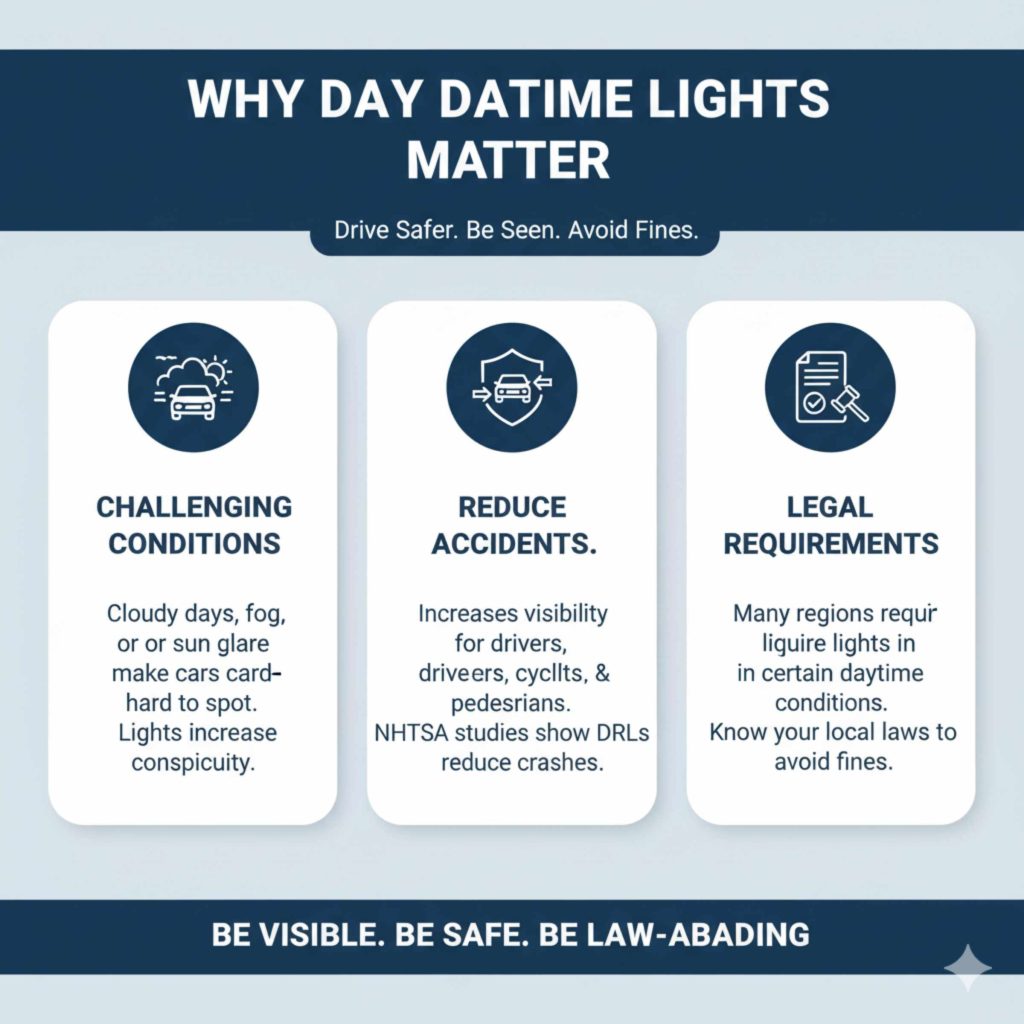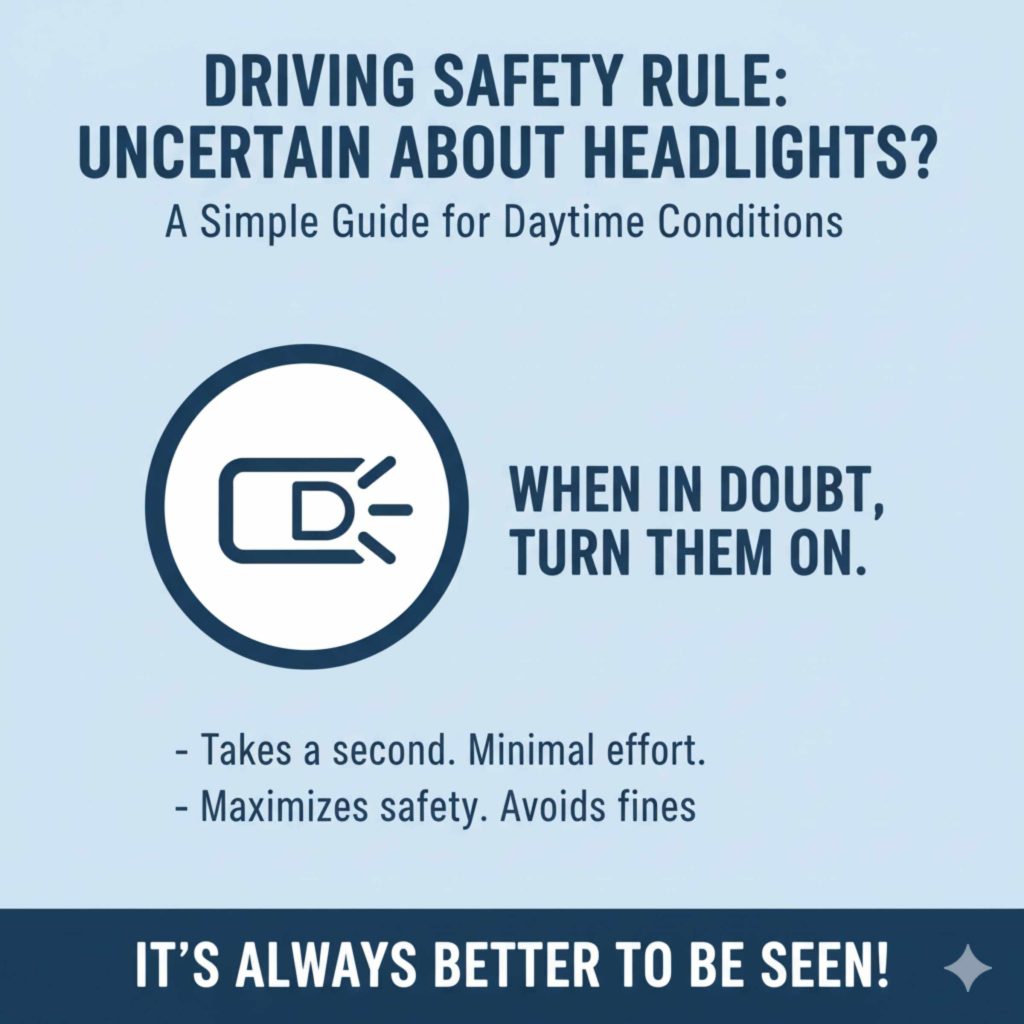Yes, in many situations, you do have to have your car lights on during the day for safety and legal reasons. This guide breaks down when and why, making it super simple for any driver.
Navigating the rules of the road can sometimes feel confusing, especially when it comes to something as simple as your car lights. You might wonder, “Do I really need my headlights on when it’s bright outside?” It’s a common question, and understanding the answer can make you a safer and more informed driver. Driving without proper lighting, even during the day, can lead to misunderstandings with other drivers or even a ticket. But don’t worry! This guide is here to clear things up. We’ll walk through the ins and outs of daytime driving lights, explain why they’re important, and help you feel confident about when to switch them on. Let’s get your visibility sorted, so you can drive with peace of mind.
Why Daytime Lights Matter
Even on a sunny day, your vehicle’s lights play a crucial role in ensuring other drivers can see you. While daylight provides general visibility, certain conditions can make your car harder to spot. This is where your lights come in, acting as a vital safety feature that many drivers overlook.
Visibility In Challenging Conditions
Think about driving on a cloudy day, through fog, or when the sun is low on the horizon, creating glare. In these moments, your car can blend in with its surroundings, making it difficult for others to judge your speed or presence. Daytime running lights (DRLs) or even your low-beam headlights can significantly increase your car’s conspicuity, meaning how easily it can be seen.
For instance, studies by organizations like the National Highway Traffic Safety Administration (NHTSA) have shown that DRLs can reduce certain types of crashes. They help others see you coming, especially when they might be distracted or facing difficult driving conditions.
Reducing Accidents
The primary purpose of having lights on during the day is accident prevention. When your lights are on, your vehicle becomes a more visible target for other drivers, cyclists, and pedestrians. This is especially true for motorcyclists, who are often required to have their headlights on at all times. The principle is the same for cars: being seen is a key part of staying safe.
Legal Requirements
Beyond safety, there are legal reasons to keep your lights on. Many regions and states have specific laws regarding when headlights must be used, and these often extend to daytime conditions under certain circumstances. Understanding these laws can help you avoid unnecessary fines and ensure you’re always driving legally.

When Are Daytime Lights Required?
The question of “Do you have to have car lights on during the day?” doesn’t have a simple “yes” or “no” answer for all situations. The requirement often depends on specific driving conditions and local laws. Here’s a breakdown of common scenarios where turning on your lights is either legally mandated or highly recommended for safety:
Adverse Weather Conditions
This is one of the most common situations where daytime lights are crucial and often legally required. If visibility is reduced due to:
- Rain: Even light rain can create splashes and reduce visibility.
- Snow or Sleet: Falling snow or sleet drastically limits how far you can see and how easily others can see you.
- Fog: Fog is notoriously dangerous, making it essential for your car to be visible from a distance.
- Dust or Smoke: Smoke from wildfires or dust storms can obscure your vehicle.
In these conditions, your headlights or DRLs make your car appear as a brighter, more distinct shape against the background, alerting oncoming traffic and those behind you.
Low Light Conditions
Even when it’s not raining or snowing, certain times of day can present low-light challenges:
- Dawn and Dusk: These are transitional periods. The sun might be low, causing glare, or twilight can make colors harder to distinguish, making your car less visible.
- Overcast or Cloudy Days: A heavily overcast sky can significantly dim daylight, making your car appear less prominent.
- Tunnels: While tunnels have artificial lighting, it’s often not bright enough to ensure your car is seen by others entering or exiting, or even within the tunnel itself. Entering and exiting tunnels marked with specific signs often require headlights.
Driving Outside Your Established Region
Laws can vary significantly from state to state, province to province, and even country to country. If you’re traveling, it’s wise to familiarize yourself with the headlight laws of the area you’ll be driving in. Some jurisdictions have “headlight usage” laws that are quite broad.
Specific Roadways
Some highways or specific zones might have signage indicating that headlights must be used at all times. Always pay attention to road signs.
Driving Next to or Behind Large Vehicles
Cars can be hidden in the blind spots of larger vehicles like trucks. Using your headlights can help truck drivers be more aware of your presence, even during the daytime.
When Your Windshield Wipers Are On
A common and practical rule across many places is that if your windshield wipers are on due to precipitation, your headlights must also be on. This is because the wipers are an indicator that visibility is reduced by weather.
Understanding Your Car’s Lighting Systems
Your car is equipped with several types of lights, and knowing what they are and when to use them is key.
Headlights (Low Beams)
These are your standard driving lights. While they are bright enough to illuminate the road ahead, they are also designed to be seen by others. In many places, using your low-beam headlights is the default when conditions require more visibility, including many of the daytime scenarios mentioned above.
Daytime Running Lights (DRLs)
Many modern vehicles come equipped with DRLs. These are lights that automatically turn on when the engine is running and are less bright than your headlights. They are specifically designed to make your vehicle more visible to others during periods of daylight.
Placement: DRLs can be integrated into the headlight assembly, taillights, or be separate lights on the front of the vehicle.
Function: They are usually a lower-intensity version of the headlight beam or dedicated LEDs. They do not significantly illuminate the road ahead but serve primarily to make your car more conspicuous.
In countries like Canada, DRLs are mandatory on all new vehicles. In the United States, they are not federally mandated but are common on many vehicles.
Automatic Headlight Systems
Many cars have an “Auto” setting for the headlights. These systems use a sensor, usually located on the dashboard or windshield, to detect ambient light levels. When the sensor determines that light is too low, it will automatically turn on your headlights.
How they work: The sensor measures the amount of light hitting it. If the light drops below a certain threshold (like during dusk, dawn, tunnels, or rain), the system activates the headlights.
Reliability: While helpful, these systems aren’t foolproof. They might not always detect conditions like heavy fog or snow immediately, or they might react a bit late. Therefore, it’s always good to be aware of your surroundings and manually engage your lights when needed.
Hazard Lights (Emergency Flashers)
These are your flashing red lights, used to signal a problem or a hazardous situation. They are not meant for general use during the day to increase visibility. Use them only when you are stopped on the roadside, moving very slowly due to an issue, or in a very hazardous situation.
Legal Regulations: What the Law Says
Laws regarding daytime headlight use vary significantly. It’s essential to know the specific rules for where you live and travel.
General “Headlights Use” Laws
Many states and countries have laws that mandate the use of headlights in specific conditions. These often include:
When windshield wipers are in continuous use due to precipitation.
During periods of insufficient visibility (fog, smoke, dust, etc.).
From dusk till dawn.
It’s worth noting that “insufficient visibility” can be broadly interpreted by law enforcement, meaning it’s often better to err on the side of caution and turn on your lights.
Specific State/Country Examples (Illustrative)
Here’s a general idea of how some regulations might be structured. Please verify the exact laws for your location.
| Condition | Example Law Interpretation | Notes |
|---|---|---|
| Rain/Snow/Sleet | Headlights required if wipers are in continuous use. | Many states require this. |
| Fog/Smoke/Dust | Headlights required when visibility is reduced to less than a certain distance (e.g., 1,000 feet). | Focuses on limited sight distance. |
| Dusk/Dawn | Headlights required from sunset to sunrise. | Standard night driving requirement. |
| Daytime Running Lights (DRLs) | Not universally mandated for use during the day, but if your vehicle has them, they are often sufficient. | Varies by vehicle and region. |
A great resource to check for specific U.S. state laws is often the Department of Motor Vehicles (DMV) website for that state. For instance, the Pennsylvania Department of Transportation provides clear guidelines on lighting equipment.
The Importance of Checking Local Laws
Because laws change and vary widely, the best approach is to check the official Department of Motor Vehicles (DMV) or equivalent road safety authority website for your specific region. This ensures you have the most accurate and up-to-date information.
Tips for Maximizing Your Visibility
Being visible isn’t just about turning on your lights; it’s about ensuring they are functioning correctly and that you’re making smart choices as a driver.
Regularly Check Your Lights
This is a simple but critical step. Periodically walk around your car and check:
- Headlights: Ensure both low and high beams are working.
- Taillights: Verify they are operational, especially when you brake.
- Turn Signals: Check that both front and rear signals are flashing correctly.
- Brake Lights: Have someone step on the brake pedal while you check that all brake lights illuminate.
- DRLs: If your car has them, ensure they activate automatically or when appropriate.
A burnt-out bulb is not only a safety hazard but can also lead to a ticket. Replacing bulbs is usually a straightforward DIY task for many common bulbs, or a quick job for a mechanic.
Clean Your Lights
Over time, headlight lenses can become hazy, yellowed, or scratched. This significantly reduces their brightness and effectiveness.
Hazing/Yellowing: This is often caused by UV radiation from the sun deteriorating the plastic. You can often restore them using a headlight restoration kit, which involves sanding and polishing. Many auto parts stores sell these kits.
Dirt and Grime: Regularly washing your car and wiping down your headlights will keep them as clear as possible.
Use the Right Lights for the Conditions
DRLs vs. Low Beams: If your car has DRLs, they’re great for clear days where increased visibility is helpful. However, in conditions of reduced visibility (rain, fog, dusk), switch to your low-beam headlights for better illumination and to ensure your taillights are also illuminated, which DRLs often do not activate.
* High Beams: Use high beams only when there is no oncoming traffic and you need to see further down the road. They can blind other drivers, and using them inappropriately can lead to a ticket.
Slow Down in Poor Visibility
Even with your lights on, if visibility is poor, reduce your speed. This gives you more time to react to hazards and makes it easier for others to see your vehicle.
Be Aware of Your Surroundings
Always be mindful of other drivers, cyclists, and pedestrians. Use your turn signals well in advance of a turn or lane change. Defensive driving, combined with proper lighting, is the best way to stay safe.
What to Do If You’re Unsure
If you’re ever uncertain whether you should turn on your headlights during the day, follow this simple rule:
When in doubt, turn them on.
It takes just a second to flip the switch, and the potential benefits in terms of safety and avoiding a ticket far outweigh the minimal effort. Driving with your lights on during conditions of reduced visibility is always a better choice than driving with them off.

Frequently Asked Questions (FAQ)
Q1: Do I need to turn on my headlights if my car has daytime running lights (DRLs)?
A: Generally, if your vehicle is equipped with DRLs, they are designed to increase your visibility during daylight hours. However, DRLs usually do not activate your taillights. For conditions with reduced visibility (rain, fog, tunnels, dusk), you should switch to your low-beam headlights to ensure both your front and rear lights are on. Always check your local laws.
Q2: My car has an “Auto” headlight setting. Is that always enough for daytime driving?
A: The “Auto” setting is very convenient and works well in many situations, like dusk or driving into a tunnel. However, it relies on sensors that might not always detect conditions like heavy fog, snow, or rain immediately. It’s best to be observant and manually turn on your lights if you feel visibility is compromised, even if the “Auto” setting hasn’t engaged them yet.
Q3: Can I get a ticket for not having my headlights on during the day?
A: Yes, you absolutely can. Many jurisdictions have laws requiring headlights to be on during specific daytime conditions, such as during precipitation, in fog, or when visibility is otherwise reduced. It’s important to know the laws in your area to avoid fines.
Q4: Are my taillights on when my DRLs are on during the day?
A: Typically, no. Daytime Running Lights (DRLs) usually only illuminate the front of your vehicle to make it more visible. Your taillights and license plate lights generally do not activate with DRLs. This is why switching to your low-beam headlights is recommended in adverse conditions, as this will turn on all your exterior lights.
Q5: How can I check if my car’s lights are working properly?
A: It’s easy! With your car parked safely, turn on your headlights, turn signals, and hazard lights. Then, have a friend or family member stand behind your vehicle while you gently press the brake pedal to check the brake lights. You can also walk around the car to visually confirm all lights are functioning and are not dim or hazy.
Q6: My headlight lenses are foggy. Does this really affect my lights?
A: Yes, foggy or yellowed headlight lenses can significantly reduce the brightness and effectiveness of your lights. They scatter light and can make it harder for your headlights to illuminate the road ahead and for others to see your vehicle. Using a headlight restoration kit can often clear them up, or you can replace the entire headlight assembly.
Conclusion
Understanding when to use your car lights during the day boils down to a simple principle: if there’s any doubt about being seen, turn them on. While modern cars with DRLs and auto-headlight settings have made things easier, they are not a replacement for a driver’s awareness. By knowing the common scenarios that require headlights—like rain, fog, dusk, and dawn—and by performing simple checks on your vehicle’s lighting system, you can significantly enhance your safety and the safety of others on the road. Always remember to check your local driving laws to stay compliant. Driving with your lights on when needed is a small act that makes a big difference in ensuring everyone gets to their destination safely. Stay safe out there!

